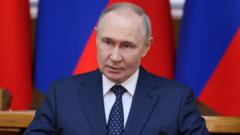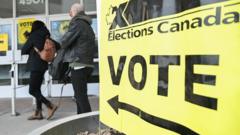In a historic election, Canadians are responding to economic pressures and political transformations fueled by U.S. foreign policy.
Canada's Crucial Election: Will Trump's Influence Shape Leadership?

Canada's Crucial Election: Will Trump's Influence Shape Leadership?
As Canadians cast their votes, the shadow of Trump's trade policies looms large, forcing pivotal choices in leadership.
Canadians are voting on a decisive day that could reshape their political landscape, with millions heading to the polls amid significant economic and political turmoil. The election is closely contested between Prime Minister Mark Carney of the Liberal Party and Pierre Poilievre of the Conservative Party, both of whom have adopted contrasting stands regarding U.S. President Donald Trump’s tariff threats and economic policies.
Just months ago, the Conservative Party, led by the charismatic Poilievre, was projected to win with a comfortable lead. However, the abrupt resignation of Justin Trudeau from leadership and a surge in tariffs proposed by Trump have dramatically altered the campaign dynamics, leading to a favorable shift for the Liberals under Carney's guidance. As Canadians evaluate their next leader, they are also confronting the broader implications of Trump’s criticisms and tariffs, which have become central to their decision-making process.
Carney, a centrist previously leading the Bank of Canada and the Bank of England, has painted himself as the defender of Canadian sovereignty in the face of U.S. aggression. He focuses on leveraging his expertise to safeguard Canadian jobs and the economy against Trump’s aggressive trade strategy. In contrast, Poilievre, a lifelong politician, has faced increasing scrutiny for resembling Trump in tone and policies. While he advocates for deregulation and a reduction in government size, critics argue that his alignment with Trump’s populism could deter moderate voters concerned about national sovereignty.
As polls opened across the country, voter turnout surged, bolstered by concerns regarding the affordability crisis, housing prices, and the looming threat of a recession linked to American tariffs. Each party is competing to address pressing issues faced by Canadians, such as the skyrocketing cost of living, particularly in urban areas like Vancouver and Toronto.
The stakes are particularly high given that results may emerge late into the night, as hand-counting ballots across six time zones will take time. A plethora of candidate positions and party platforms have emerged in the lead-up to the election, igniting debates on key issues like Indigenous rights, climate policies, and Canada's response to increasing pressures from the U.S. The challenge now is whether Carney can galvanize support or if Poilievre will harness the discontent among voters pushing for reforms that resonate with their frustrations.
As the candidates make their final appeals and the public begins to vote, the overarching question remains: Who can best navigate Canada’s sovereignty in an era entwined with U.S. influence, and which vision will ultimately be embraced by the electorate?






















